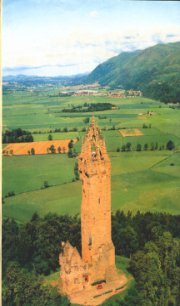


William Wallace
"Braveheart"
William Wallace did not fight and die for Scotland’s freedom alone. He fought for the right of men and woman to live in peace, and that they could enjoy a way of life that did not mean bonded slavery, degradation and living without a home. I believe if Wallace were here today, he would recognize that the fight for our people is still with us, only the tactics have changed. Anyone who calls themselves a Scot or a patriot should feel ashamed if they do not contribute to the wellbeing of others who are in circumstances less fortunate (for the moment!) than themselves.
Historical Note
The Declaration of Arbroath states that it is for freedom… and that alone that no honest man gives up but with life itself.


The pictures above show Wallace’s National Monument in Stirling, the scene of his most famous victory over the English under the command of the ageing Earl of Surrey and on the left is a close up of the statue of Wallace himself. No portrait of Wallace has ever been discovered although his five foot sword, displayed in the above monument backs up the legend of his near superhuman height.
This page is not intended to be a long winded look at the history of William Wallace the links below will take you to pages that go into it in much more depth, however as a true Scot and Patriot it would weigh heavy on my conscience if I did not convey my admiration of Scotland’s most famous son..
Absolute Disgrace
Links

 William Wallace The Truth
William Wallace The Truth
 William Wallace Braveheart 700
William Wallace Braveheart 700 Scottish National Party
Scottish National Party Ayr Branch of Scottish National Party
Ayr Branch of Scottish National Party Scots Wish for Independence
Scots Wish for Independence
Back To Main Page

Scotch Myths
The young Wallace. Wallace's father was killed fighting the English, but it is well documented that this happened in 1291, when William would have been nearly 20, not the eight year old boy portrayed in the film. Scriptwriter Randall Wallace's (Braveheart Producer) defense is that since no one knows exactly when Wallace was born, who is to say he is wrong? If he was eight years old in 1291, however, then he must have led the Scots to their 1291 Stirling victory at the tender age of 14, Highly unlikely I would say!
The English Occupation Forces.The English soldiers were no angels, and beyond doubt they would have sexually assaulted Scottish women. But there is no evidence anywhere that Edward I institutionalized a system giving English nobles sexual rights over Scottish brides on their wedding night in a ploy to encourage them to emigrate across the border
Painted Faces. This was a brilliant marketing ploy, but evidence suggests that the blue woad Mel Gibson wears (Picture Below) in the battle scenes went out of fashion around the 8th century. Fads do come back, however, as witnessed by anyone who travels to Hampden Park for an International match!

The Stirling moon. It makes great viewing, but the idea that Wallace's brilliant victory at Stirling Bridge was partly based on baring bums and willies at the assembled invaders seems most unlikely. Randall Wallace may well have been confused with more recent events at nearby Stirling Rugby Club.
Bruce at Falkirk. Robert the Bruce's appearance on the English side at the Battle of Falkirk is referred to in the medieval poem by "Blind Harry". so Randall Wallace can't be accused of making this up. However, it's highly sensitive and contentious. given Bruce's position in Scottish history. The overwhelming view of historians is that Bruce was 100 miles away on his estate in Carrick. otherwise. the portrayal of Bruce is pretty accurate: until his emergence as a national leader after Wallace's death, he was a bit of a chancer!
Princess Isabella. This is really the only serious occasion where fiction takes over from fact. Princess Isabella. daughter of the King of France, did exist in history and did marry the Prince of Wales. But this was in 1308. If we are to believe Wallace started an affair with her shortly before the Battle of Falkirk in 1298, then she would have been a mere child. Even ignoring chronological problems, the storyline is far-fetched since women in the 13th century were never sent on diplomatic missions.

 Links to some of my favourite sites on the Web
Links to some of my favourite sites on the Web
 The Realm of the Druid Princess
The Realm of the Druid Princess
 All your Technical problems solved here!
All your Technical problems solved here!
 Heavens Gate, A to Z of Cults
Heavens Gate, A to Z of Cults
 The National Trust for Scotland
The National Trust for Scotland
For places of Historic Interest or Natural Beauty in Scotland.
© 1997 davidandelaine@ntlworld.com
© 1997 davidandelaine@ntlworld.com
![]() View My Guestbook
View My Guestbook


![]() Get your own Free Home Page
Get your own Free Home Page